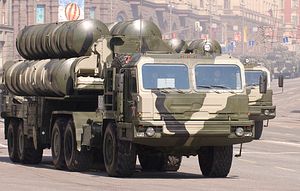Responding to the recent news that India and Russia will ink a contract in 2017 for the procurement of four to five regiments of Russian-made S-400 Triumf advanced Air Defense Systems (NATO reporting name: SA-21 Growler), the Pakistan military is now purportedly considering purchasing a number of S-400 units as well, a high-ranking Pakistan military official told Russian state media on February 15.
“Russia has good tanks, helicopters, electronic equipment, air defense systems that Pakistan may consider. S-400 is a big ticket number and it will all depend on our budget,” the military official told Sputnik News, the foreign language arm of Russian news agency RIA Novosti. Pakistan officially spends about $7 billion annually on defense, although the real number may be substantially higher, and is in the process of modernizing its military forces.
Yet while the country’s economy has grown a solid 4.7 percent in 2016 and is expected to continue to expand by 5 percent in 2017 (partially due to Chinese investments under the Chinese-led China-Pakistan Economic Corridor) allowing for a modest military spending increase, the Pakistan military’s big ticket budget priorities are clearly on new combat aircraft, submarines, surface warships, and the country’s various indigenous missiles programs.
To adequately defend Pakistan airspace, the military would need to deploy at least three regiments of S-400 with total procurement cost potentially as high as $2.5 billion. (“One S-400 regiment is usually divided into two battalions each of which capable of deploying eight launchers and a total of 32 surface-to-air missiles,” I explained elsewhere.) Given that Pakistan was not able to or willing to pay $700 million for eight F-16 fighter jets (a clear budgetary priority) from the United States in 2016 following Washington’s refusal to provide Foreign Military Financing (FMF) support, it is highly doubtful that the country’s defense ministry would allocate $2 billion or more for a new missile air defense system in the near future given other defense priorities.
As an alternative to the S-400, Pakistan could perhaps opt for the cheaper Chinese-made HQ-9 (export designation FD-2000) surface-to-air missile (SAM) system, a derivative of the Russian-made S-300 long-range SAM system that can engage aircraft, cruise missiles, and theater ballistic missiles at a range of up to 200 kilometers and a flight ceiling of around 27 kilometers. China and Pakistan first started negotiations over a possible HQ-9 deal in early 2015. However, little progress has been made so far and it is unclear whether Pakistan is still interested in the SAM system.
Furthermore, the unnamed military official told Sputnik News that Pakistan might be interested in procuring additional combat helicopters from Russia. “Pakistan considers expending the existing Mi-35 helicopters contract with Russia, a number of additional machines will depend on our budget. According to the existing contract, Russia will supply four pieces to Pakistan,” he said.
Pakistan’s military is slated to receive four Russian-made Mi-35M attack helicopters in 2017 for a purchasing price of $153 million. This number could increase to a total of 20. “Given the cost of building the necessary Mi-35M logistics and maintenance infrastructure, expanding the fleet beyond four aircraft would financially be a sound decision for the Pakistani military,” I explained elsewhere (See: “Pakistan to Receive 4 Attack Helicopters From Russia”).
Russia lifted a longstanding arms embargo against Pakistan in 2014 and has been seeking closer defense ties with Islamabad ever since. This has been accelerated by India’s burgeoning defense relationship with the United States and the Russian defense industry’s loss of market share in India, although Moscow remains by far New Delhi’s biggest military hardware supplier overall. Given the importance of the Indian market to the Russian defense industry, Moscow has to walk a careful balancing act in its dealings with the two South Asia rivals and it will continue to do so for the foreseeable future.
































